- Accueil
- Explore the history of the Gare Saint-Lazare, a Parisian treasure entwined with art, culture and heritage, a pivot of the modern world.
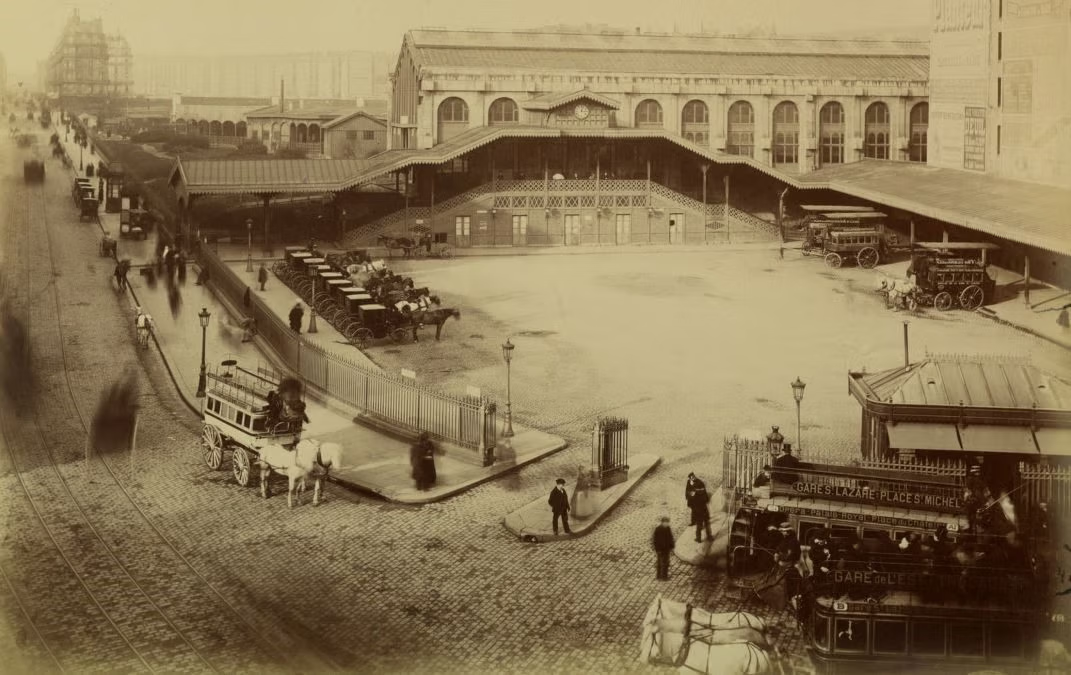
The history of the Gare Saint-Lazare: a historic Parisian monument
The history of the Gare Saint-Lazare: a historic Parisian monument
History of the Gare Saint-Lazare
The Gare Saint-Lazare has been a unique Parisian living space for over two centuries. A place at the heart of passenger transport in Europe. Several railway lines have even been immortalised in various works of art, notablythe paintings of Claude Monetexhibited at the Musée d’Orsay. Of all the stations in Paris, this one stands out because of its architecture, its association with art, and the fact that it provides direct access to Normandy in Western France via a direct line that links the largest Normandy towns.
Nearly two centuries of art and history
Gare Saint-Lazare 1837 - 1885
Did you know? Before it became the starting point forcountless destinations across France, the Gare Saint-Lazare was built in 1837 during the reign of King Louis-Philippe I. The Gare Saint-Lazare was the very first station in Île-de-France and Paris! It was built by the architect Alfred Armand and the engineer Eugène Flachat. The Gare Saint-Lazare was testament to the importance of the industrial revolution.
The inauguration of the Gare Saint-Lazare therefore marked the opening of the railways in Paris, with the very first line leading to Saint-Germain-en-Laye in the suburbs. Also nicknamed “the first pier in Paris”, it therefore represents the departure and arrival point of the first railway built between Paris and Le Pecq in Yvelines.
It has been extended several times in response to the growth in railway traffic in Paris and the SNCF, and although further lines and tracks have been added, it has survived the centuries while preserving all its splendour. When it was first constructed, the Gare Saint-Lazare consisted of 5 metallic halls which accommodated the various trains.The Gare Saint-Lazare has always been thestarting point for those wishing to explore Paris
The year 2012 saw the opening of the Gare Saint-Lazare shopping centre , constructed in the former salle des pas perdus.
The Gare Saint-Lazare has been depicted in several works of art, thus ushering in the advent of the railway. A revolution for that era. For example:
● ●“Vue du chemin de fer de Paris à St. Germain. Point de départ Place de l’Europe”, lithograph designed by J.-B. Arnout, created by Veith and Hauser

● “Inauguration du chemin de fer”, by Saint-Lambert, engraving on free-standing
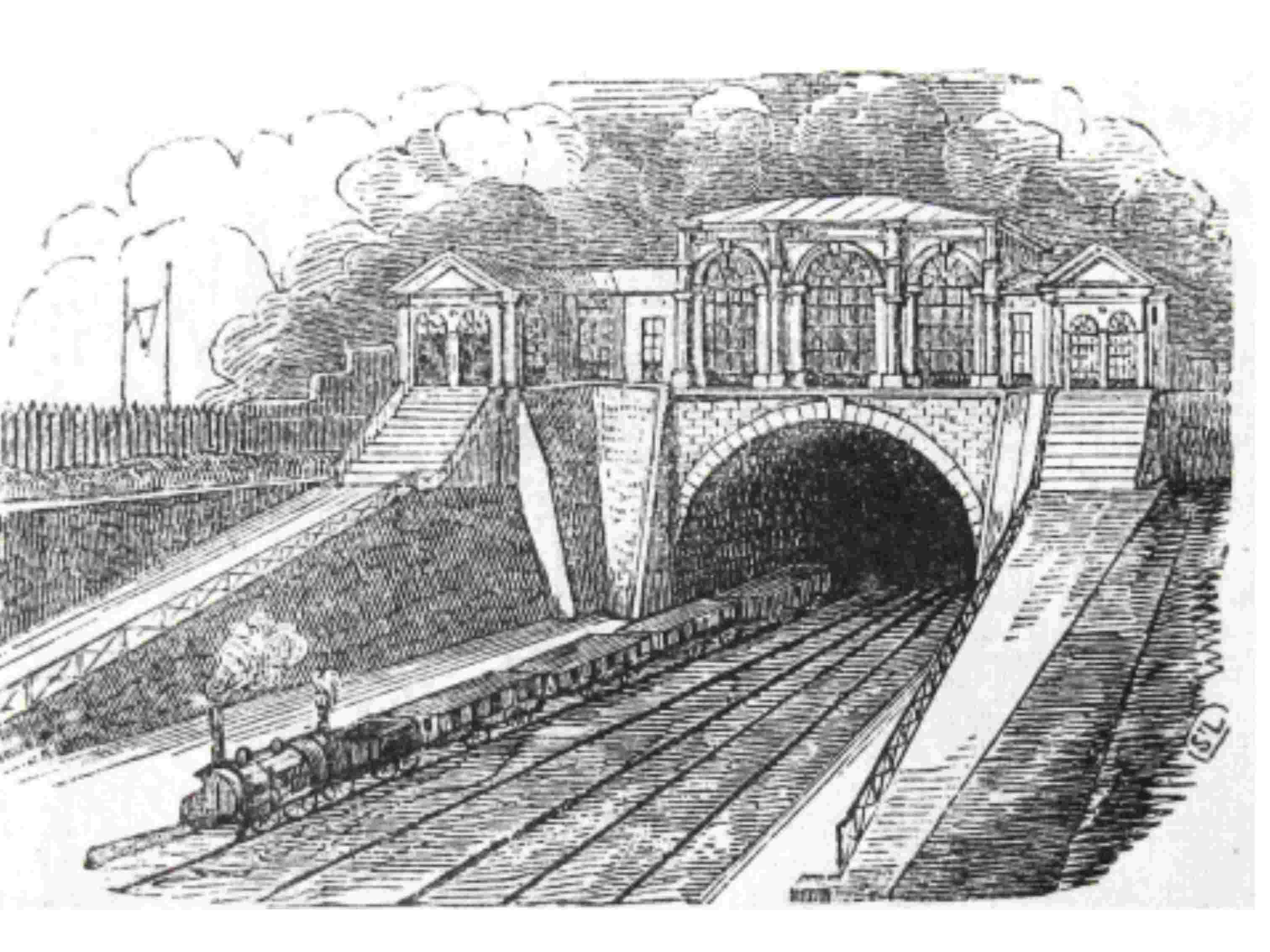
●“Chemin de fer de Paris à Saint-Germain”, steel engraving by Rouargues
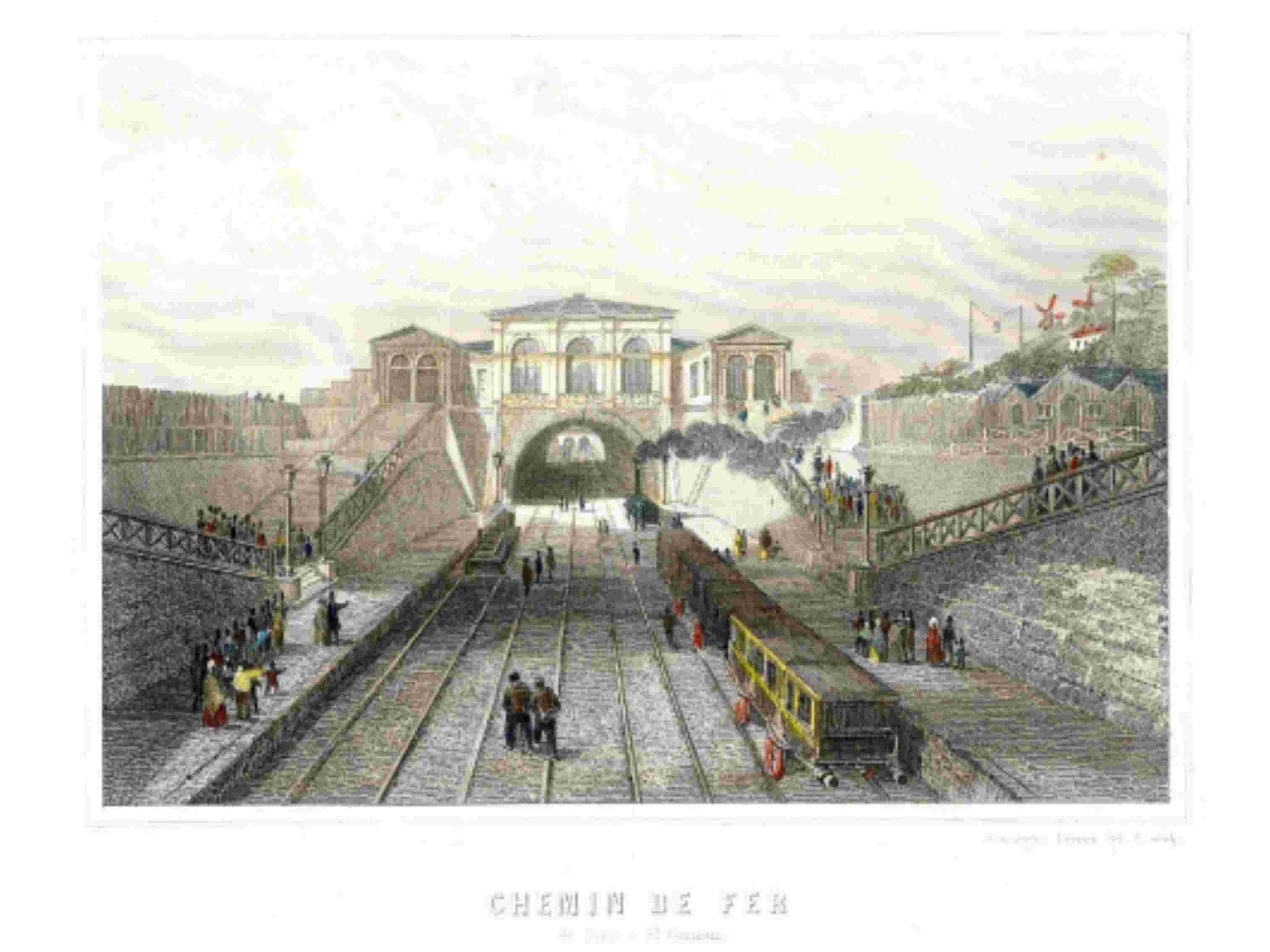
● “Vue du télégraphe électrique à l’entrée du tunnel du débarcadère du chemin de fer de Saint-Germain”, engraving on free-standing wood, by Champin
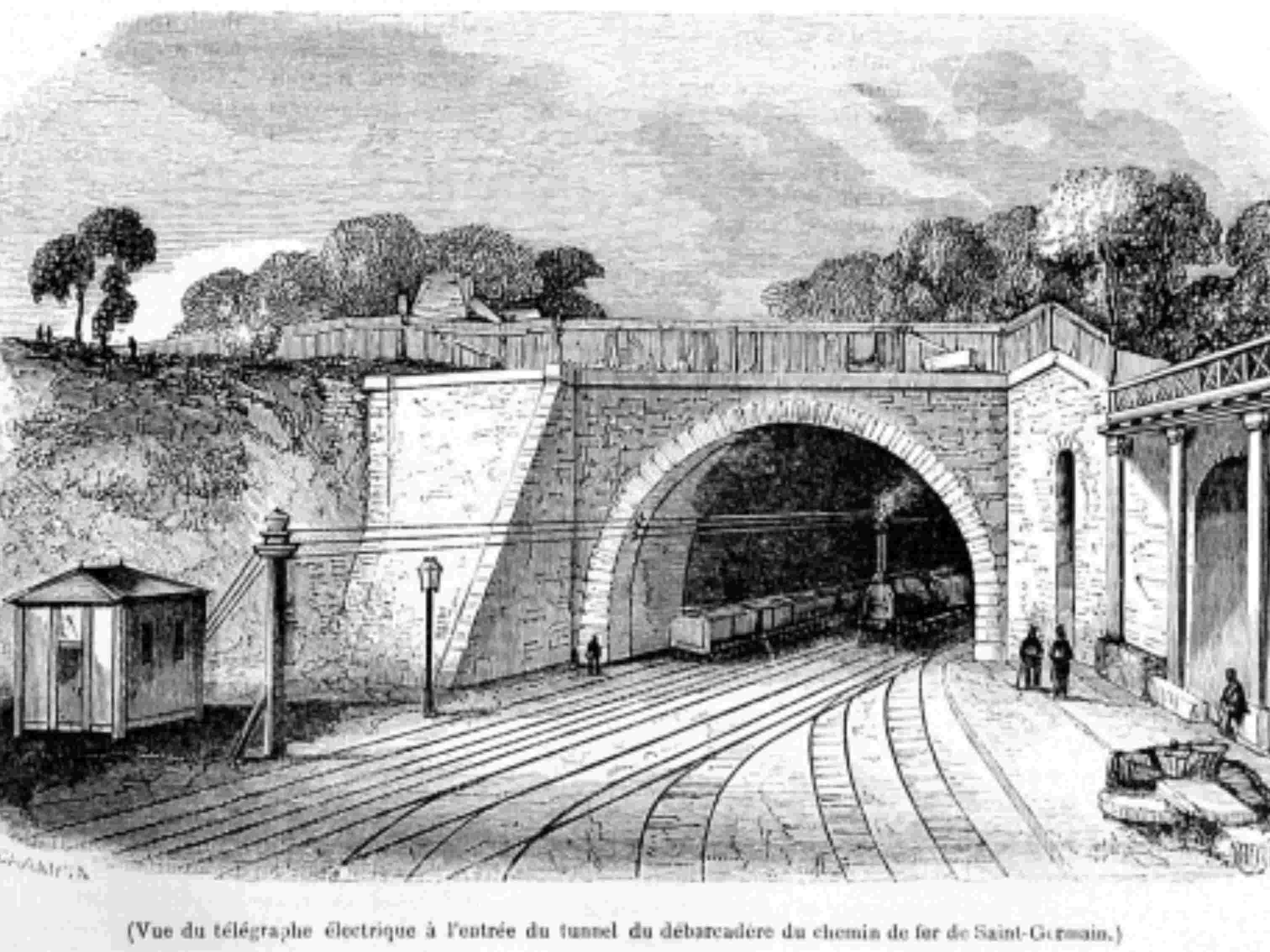
the Gare Saint-Lazare from 1885 to the present today
From 1885 to 1887, the French architect Juste Lisch carried out construction work involving the enlargement of the Gare Saint-Lazare and its railway tracks. The main intention was to renovate the facade in a classic style.
At the same time, the Terminus Hotel was also built to accommodate European and international travellers arriving to see the Universal Exhibition of 1889, the date on which the Eiffel Tower was erected. The Terminus has now become the Hilton Hotel. In total, there are 27 railway tracks transporting nearly 450,000 passengers a day. The Gare Saint-Lazare is the second largest station in Europe in terms of traffic. Of all the stations in Paris, it is the Gare du Nord, which connects four European countries and the northern suburbs of Paris, which is at the head of this ranking.
Since 1984, the Gare Saint-Lazare has been listed as a historic monument. This classification makes this Parisian station a museum inside a station, an original idea. However, the Gare Saint-Lazare is primarily a crossing point for those destined for key places in France such as Le Havre, Rouen, Cherbourg, Caen and Trouville.
Then in 2012 this famous building, housing several railway tracks, underwent further renovations. The Salle des Pas Perdus was then replaced by the shopping centre. The skylight installed during this transformation allows natural lighting on all three floors of the centre.
Outside the building, on the Place de Rome, the lens-shaped glass bubble leading to the metro station gives the Gare Saint-Lazare a modern feel.
Facade, glass ceiling and departure lounge
When passing through the Gare Saint-Lazare, be sure not to miss the facade, its roofs, its glass ceiling and departure lounge, which are particularly remarkable! The Gare Saint-Lazare is a true crossroads for those travelling in Paris, France and Europe. This iconic station in the heart of Paris embodies the power and evolution of the French railway network. As mentioned above, it became a symbol of its era, when the very first line to Saint-Germain-en-Laye in the suburbs of Paris was constructed. In his 12 oil on canvas works, Claude Monet painted the SNCF station from different view points, demonstrating the importance of the industrial revolution in France and Europe, with the station positioned as a focal point in the heart of Paris.
facades of the Gare Saint-Lazare
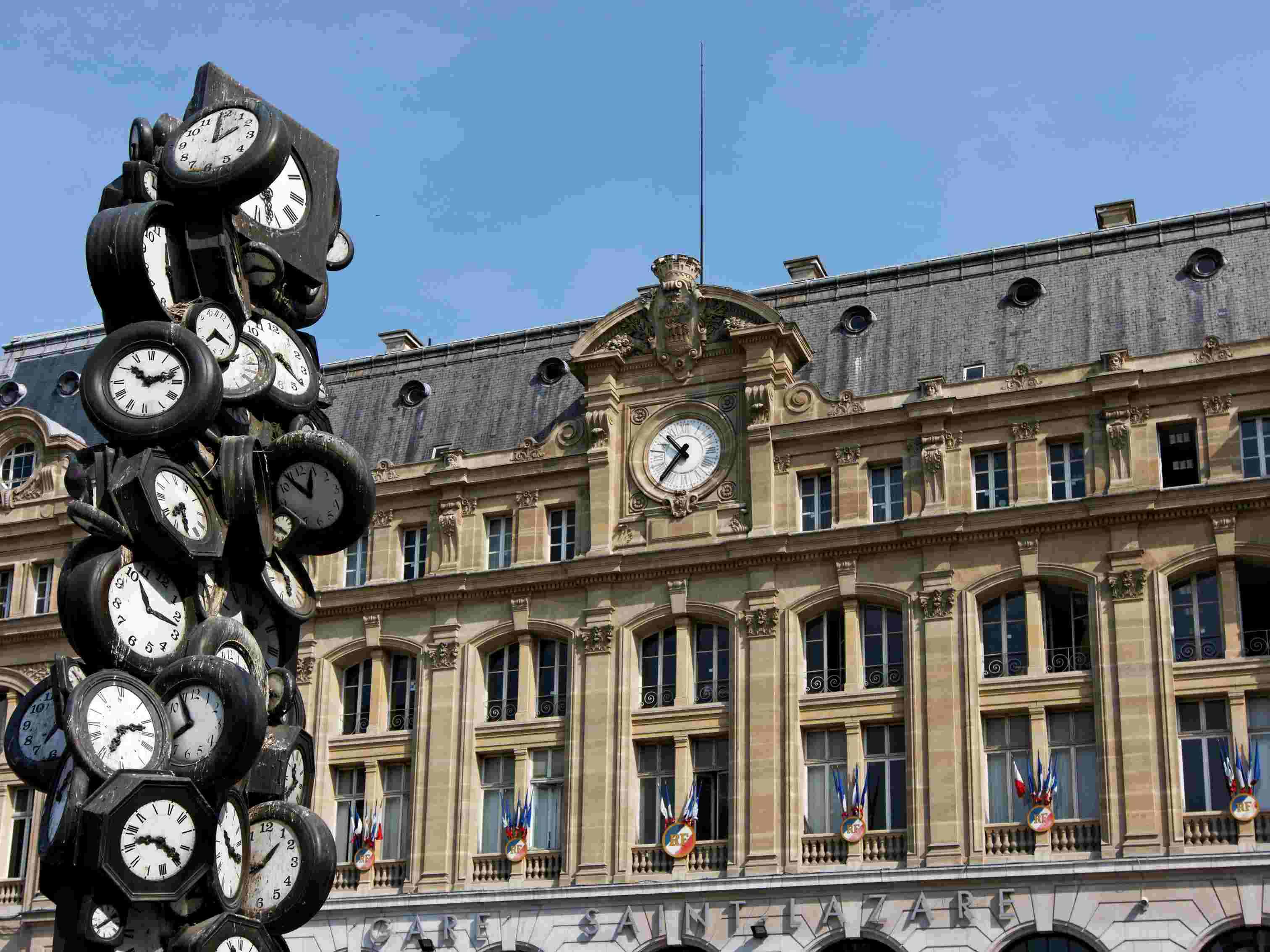
Unmissable! Travellers coming or going can explore magnificent architecture where history, art and modern ideas collide. The facade, listed as a historic monument, offers a majestic first impression with its sculptural details, which recall the golden age of railways and railway lines.
The lines from Gare Saint-Lazare in Paris serve key destinations across France and beyond, with a direct line from Paris to Normandy, creating unbreakable links with the rest of the European continent and even with transatlantic destinations.
amazing roofing and glass ceilings in Paris
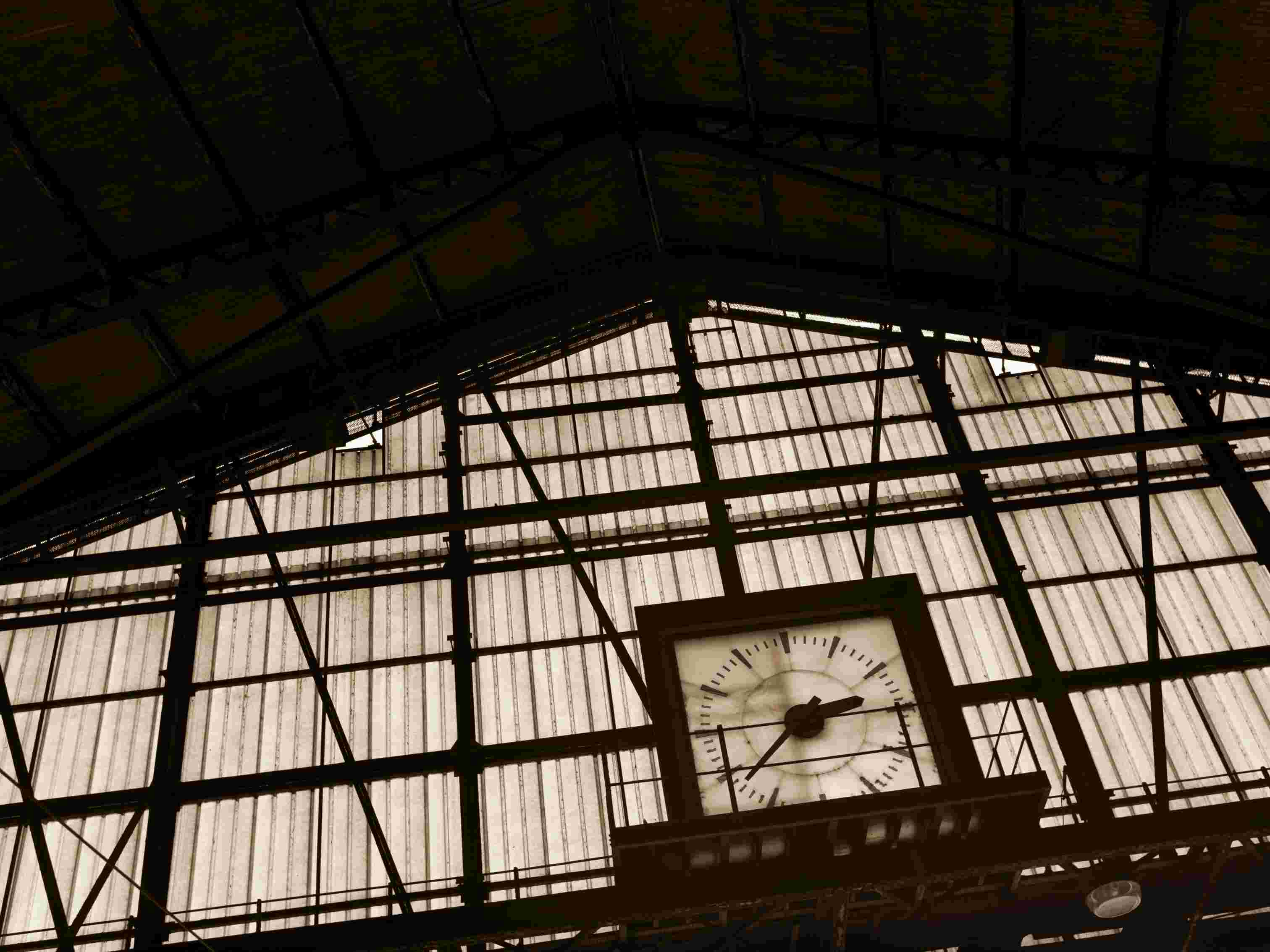
The roofing and glass ceilings of the Gare Saint-Lazare bathe the interior space in dazzling natural light, emphasising the ingenuity and technical prowess of their design. It is a visual spectacle reminiscent of the paintings of Claude Monet, where light plays on metallic structures, capturing the effervescence and perpetual movement of the station and the railway system in general.
the Gare Saint-Lazare departure lounge
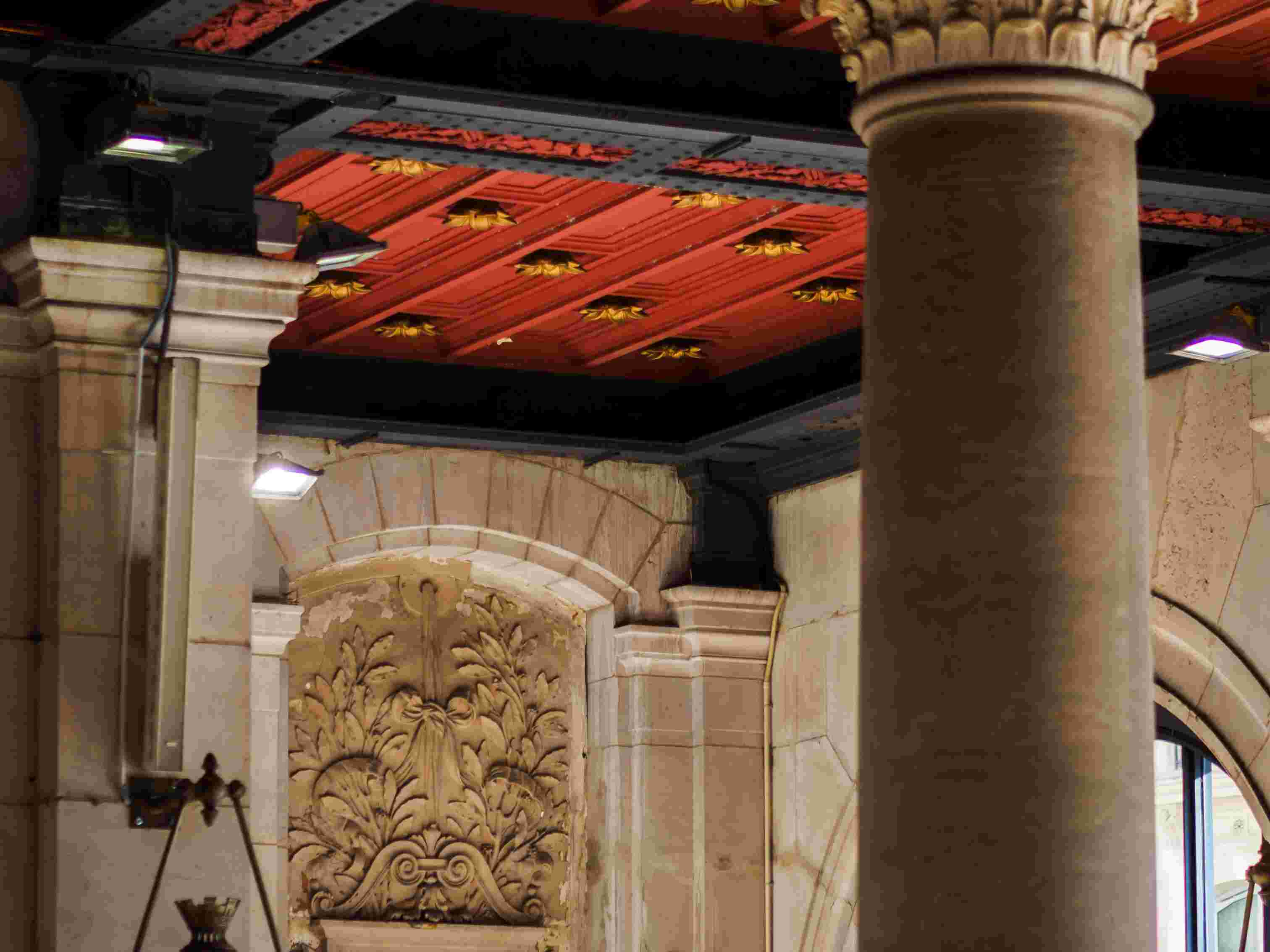
The Gare Saint-Lazare departure lounge is the true lifeblood of the station: a lively, dynamic space. This is where millions of travellers cross paths every day, a place of meetings and exchanges. It is a reflection of the diversity and openness of France. Each track, each platform, and each line is a promise of travel, an invitation to explore new horizons.
The work of architects Alfred Armand and Juste Lisch is proof that the Gare Saint-Lazare is not only a transit point like other stations; it is steeped in history, an open-air museum where every architectural detail is worth viewing.
From the Gare Saint-Lazare to the Musée d’Orsay
Inside the Gare Saint-Lazare, visitors can witness both the elegance of its Iron structure, a legacy of the 19th century, and the modern style of its installations. To truly understand this legacy, which is particularly well-represented in the oil on canvas paintings of Claude Monet, Gustave Caillebotte and Édouard Manet, visit theMusée d'Orsay. The museum, with its wonderful art collection, is just a short walk from the Gare Saint-Lazare in Paris. Then, walk over the Pont de l’Europe and immerse yourself in a Paris where the art and history of transport collide, with an unrivalled view of the city and its evolution.
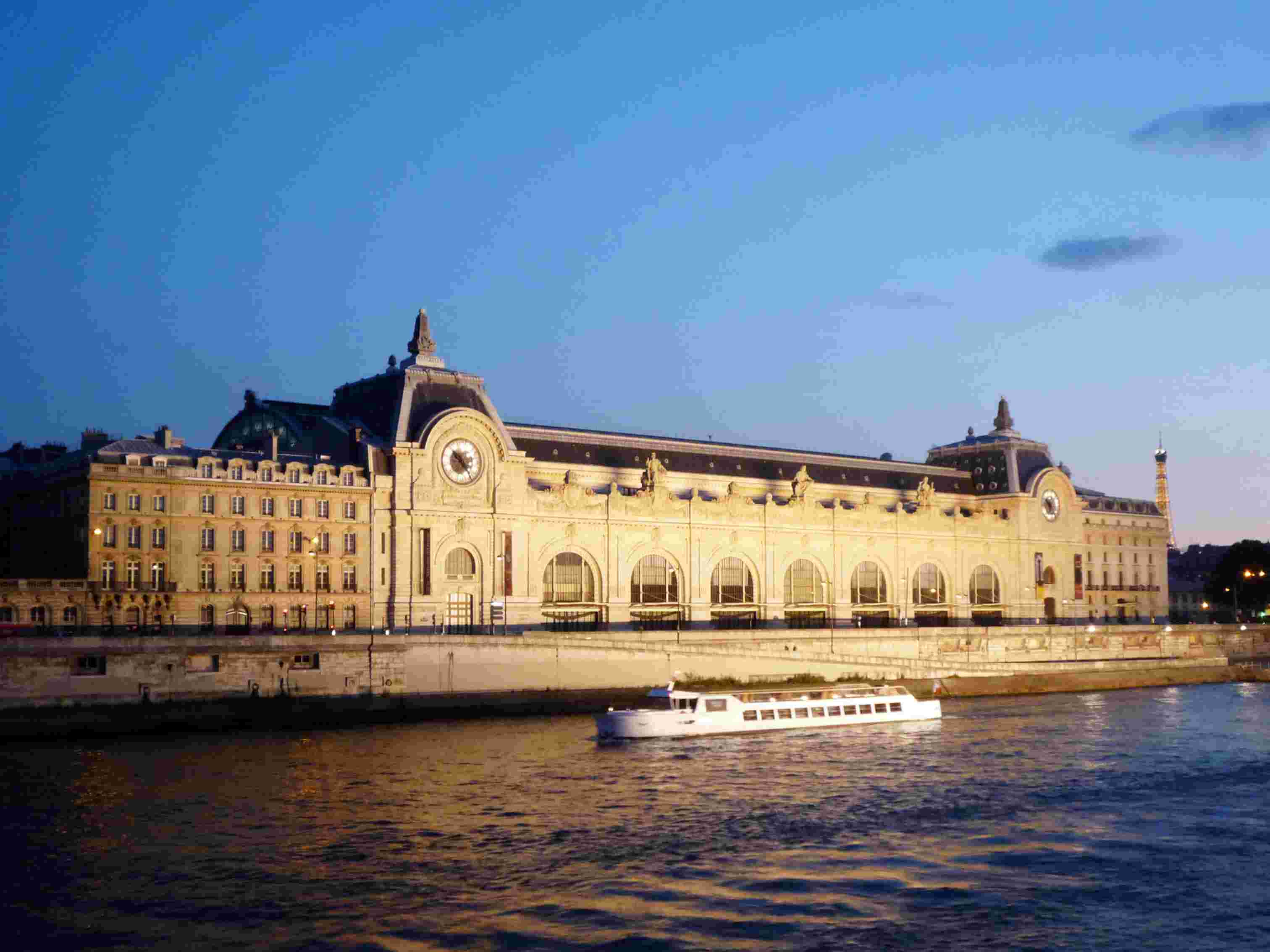
After visiting the Gare Saint-Lazare, Musée d'Orsay and Pont de l’Europe, take one of the many trains at Gare Saint-Lazare, on one of the railway lines. Departing from Paris, the terminus? Giverny, in Normandy, western France. A direct line from Paris will take you to various key destinations in Normandy, for example Le Havre or Rouen. Once in Giverny, visit the place where Claude Monet lived, admire the different views of the gardens while tracing the footsteps of his journey through impressionism. Before returning to Paris, be sure to visit the Musée des Impressionnismes. Here you will see more of Claude Monet’s work and the meticulous oil on canvas pieces of other artists.
the history of the transatlantic
The transatlantic crossing that took place in the 19th century is, of course, closely associated with the colonisation of the New World (the Americas) by European citizens. It was originally introduced by the Spanish, who set up a direct route in 1566, but it was during the 19th century that the transatlantic crossing became truly popular. The “American dream” arose out of various economic and politic problems in Europe, for example the potato famine in Ireland. Between 1864 and 1974, Normandy in France and the United States were connected by a sea link traversed by rapid, luxurious ocean liners. Do you remember which station led directly to the Normandy shipping harbours? The Gare Saint-Lazare! The Gare Saint-Lazare, at the heart of bustling Paris, therefore played a key role in the journeys of Parisian and French voyagers. Taking newly built rail routes from the Gare Saint-Lazare, travellers were fulfilling a desire for freedom and adventure. Heading for the New World!
the link between the Hilton and the Gare Saint-Lazare
The history of the Gare Saint-Lazare and theHilton opera is just as extraordinary as that of the SNCF station building that shelters the Gare Saint-Lazare railway tracks. The Grand Hôtel Terminus opened in 1889. The intention was to make it easy for travellers to get to or from their hotel, which belonged to the SNCF.
This history forms a bridge between past and present, offering an incomparable insight into the development of travel, hospitality and tourism. The 19th century transatlantic crossing is closely linked to the Gare Saint-Lazare. Remember: large numbers of trains were carrying visitors towards Normandy on these railway lines. One of the largest stations in Paris thus became an important departure point, with a direct line to a destination that was highly popular at the time. Once there, passengers would wait patiently at the pier to board ships to take them to America. Travellers could simply walk over the Eugénie footbridge to reach the platform from their hotel.
Many passengers leaving the Gare Saint-Lazare, excited by the prospect of the voyage ahead, would arrive on the platform in pyjamas, preferring to change on board the luxury ships instead of the hotel. Nowadays, the Hilton Hotelis regarded as a modern symbol of luxury and comfort for travellers. Its proximity to the Gare Saint-Lazare makes it an easy place to reach for tourists arriving by rail. All this underlines the strategic importance of stations as a junction for the different railway lines that pass through France.
The Eugénie footbridge
The Eugénie footbridge, known as the “Empress Footbridge”, is an architectural gem! In bygone times, this bridge enabled passengers boarding the boat train to walk directly from the former Hôtel Terminus (now the magnificent Hilton Paris Opera) to the Gare Saint-Lazare. It was closed for many years before being restored in 2013, and now hosts theDalloyau restaurant, which has served gourmet French cuisine since 1682. The Gare Saint-Lazare footbridge takes its name from Eugénie de Montijo, wife of Napoleon III, who is said to have used it. Also known as Empress Eugénie, she lived through the First World War, the Russian Revolution, and even the birth of cinema. She is also the only French sovereign to have been photographed in real-life images. The footbridge allowed her to move from the hotel to the station incognito. Nowadays, it is Dalloyau that pays homage to this sovereign on the footbridge of Gare Saint-Lazare in Paris. This major brand, which has been reinventing French cuisine for over 300 years, now has a prominent place in this historic, unmissable venue bursting with Parisian and French culture.

Railway station turned shopping centre
Among the metal construction, railway tracks and natural light wells there is the Gare Saint-Lazare shopping centre .. It is located in the former salle des pas perdus, which is also listed. 194 metres long (with a 213 metre-facade), since 2012 it has become a place for customers to explore its 80 shops and restaurants.
This space was immortalised by the artist Louis-Émile Durandelle in 1885 in his photograph entitled “Gare Saint-Lazare: grande salle des Pas perdus de la banlieue". The picture shows travellers making their way to one of the platforms, about to travel home or to work on one of the various railway lines.
The Gare Saint-Lazare shopping centre is not just a retail outlet. It is a cultural and commercial bridge that connects visitors to various destinations across France and Europe. With numerous railway lines and a dense network of trains, it offers direct access to the west coast and many other regions, making Gare Saint-Lazare a strategic crossroads for travellers. Once you arrive in Paris using a direct line on one of the many railway lines that reach Gare Saint-Lazare, you can enjoy a special shopping experience in a place that combines art, culture and heritage. It’s a new way to experience Paris and relive moments of the past as if you were there.
The Gare Saint-Lazare shopping centre has a privileged location that provides a window on history and art. The station is near the Musée d’Orsay, and with a direct line to Giverny, it is part of a rich cultural circuit. A circuit in which the works of Monet and other artists who immortalised the railway tracks and hustle and bustle of the stations are highlighted.
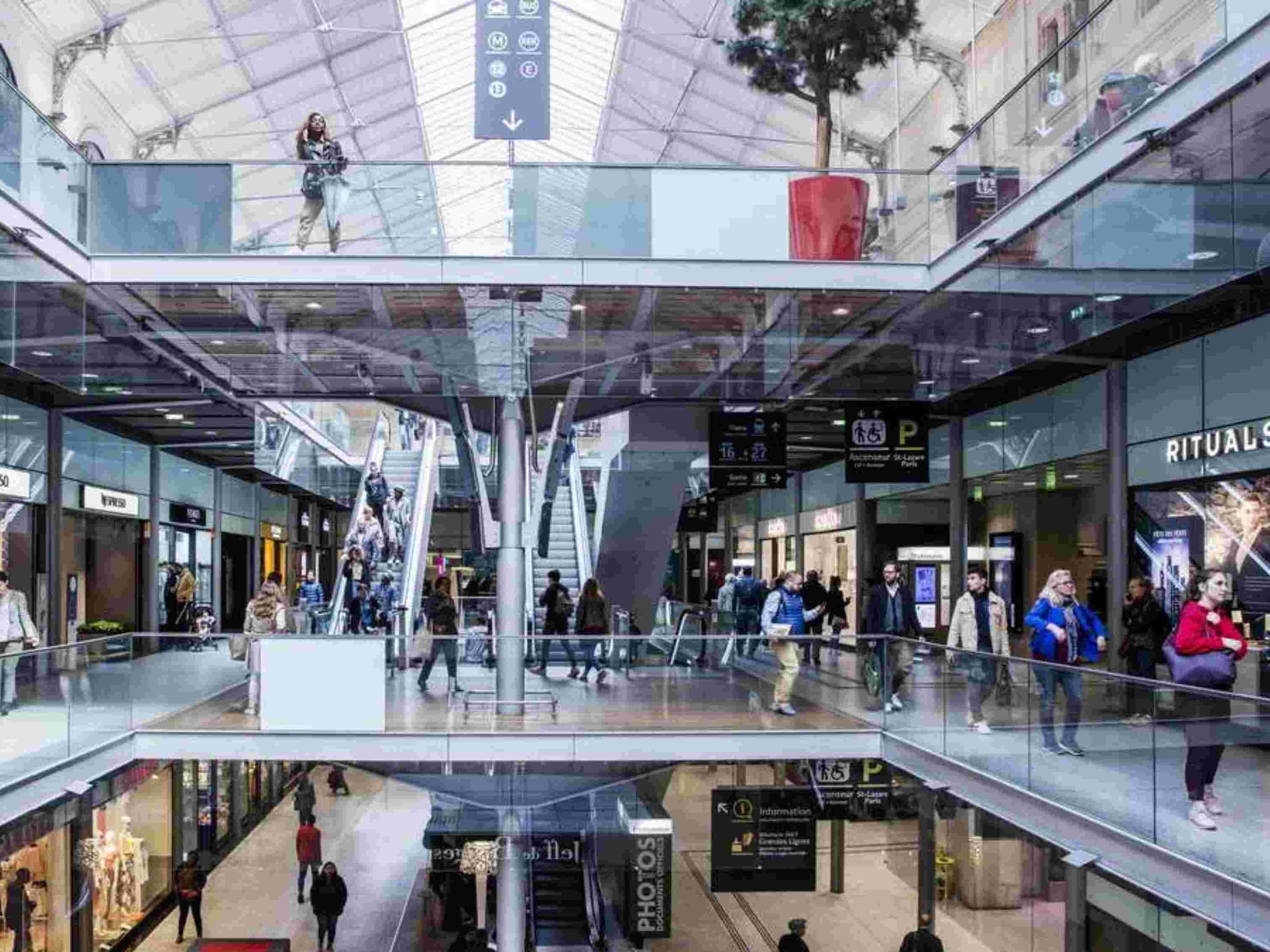
And the future of the Gare Saint-Lazare?
The Gare Saint-Lazare has undergone many transformations! While the Batignolles tunnel has become a green space, the Salle des Pas Perdus has been converted into a shopping centre. However, one thing remains the same: the Gare Saint-Lazare still connects the town of Saint-Germain-en-Laye. The “first pier in Paris” is evolving while maintaining connections to key destinations such as Le Havre, Rouen or Cherbourg.
Today, the Gare Saint-Lazare follows the codes and vision it has maintained for several centuries. The goal is to transform the station into a place even more welcoming than before. Along Rue de Rome, between Rue Cardinet and Boulevard des Batignolles - once the site of the Batignolles tunnel - Paris City Hall plans to install an enormous 3-hectare garden. The plan is to build new living space above the railway tracks of Gare Saint-Lazare. It will provide benches and tables for picnics or relaxing in the sun, while children can amuse themselves in dedicated play areas.
The Gare Saint-Lazare is gradually moving away from the industrial revolution, railway stations and industrial factories, and adopting a greener approach and an ecological moral code. New lines for the RER E are also to be built.
Train travel is currently changing, and these projects form part of a more ecological, more sustainable way of life.
Summary of the history of the Gare Saint-Lazare
To summarise, Gare Saint-Lazare is a true crossroads of history and modern ideas. It is becoming an iconic feature in the Parisian and European landscape. Its initial construction in 1837 opened up a new route to Normandy in western France and, from 1864 to 1974, it enabled close links with America to be forged. The station has been adapted many times to improve the comfort of travellers and also to accommodate the SNCF network which, over the years, has steadily expanded. The transatlantic crossing and construction of the Hilton Hotel have facilitated access to its various shipping ports, which enable travellers to reach other continents owing to the direct line to Normandy. Every day sees travellers crossing its tracks, attracted by its majestic architecture and its prominent place in the history of railways. Some even take a guided tour of the Gare Saint-Lazare, for example "Des mots et des arts", which showcases all the architectural features of the station and includes the works of Claude Monet exhibited at the Musée d'Orsay. The view from the Pont de l'Europe offers a unique perspective on the upheaval that Paris has experienced. The story narrated by the guide is testament to the importance of the station in the cultural and historical panorama. As you have discovered, the Gare Saint-Lazare is a bridge between different eras, a living space in the heart of Paris, a city that is continuously evolving while also preserving its past and its direct lines to iconic destinations. “The first pier” is being transformed while preserving its past. With promising future projects such as the transformation of its spaces to accommodate ecological gardens above its railway tracks, Saint-Lazare is committed to a greener approach, keeping pacing with current concerns about sustainability and quality of life.
Source:
GARE SAINT-LAZARE: THE SECRETS OF THE LISTED MONUMENT 02/02/2019 UNITED STATES OF PARIS
Dalloyau Saint-Lazare - The Eugénie footbridge
First Saint-Lazare station: have we seen everything? Joseph-Jean Pâques
From Le Havre to New York: the epic tale of French liners (1864-1974) BY LAURENT RIDEL ·
Paris: what if the railway tracks of Saint-Lazare were covered by an enormous garden in Batignolles? By Christine Henry, 24 May 2023 at 12:37 p.m.
Crossing the Atlantic, Wikipedia


-1_TILE_578x578)